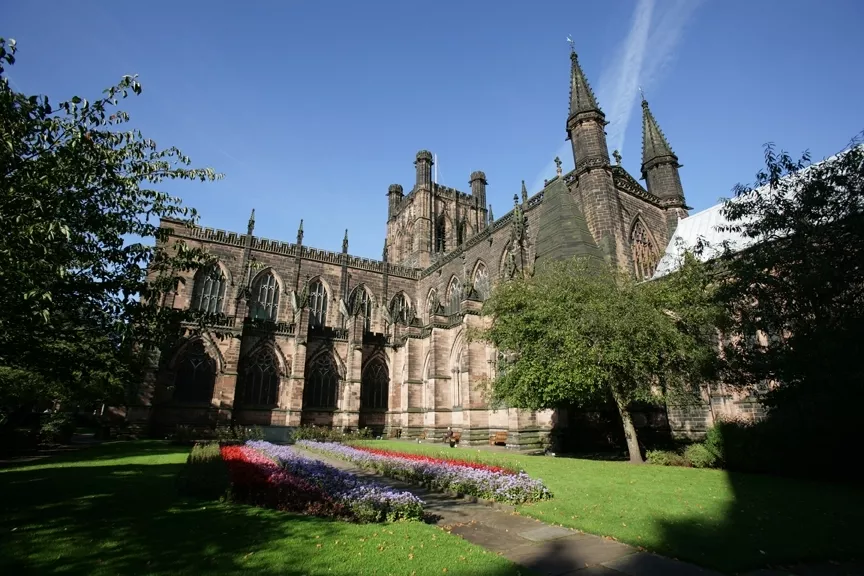Frank and his wife visited every Anglican cathedral in England and compiled a piece of prose or poem that recorded his visit. In his will, he requested that each Cathedral receive £4,000 and should be sent a copy of his written essay to be disseminated as appropriate. Here is Frank’s work.
Chester (Visited 1993)
by Frank Buzzard
Chester is the most unspoilt city I know.
Climb up Eastgate and view the architectural shops in Rows, black and white above each other; unique and quaint they bring a pleasure to shopping that many modernised city centres have lost. Walk Southwards on top of the ancient wall, passing Roman ruins and the beautiful River Dee sweeping expansively under its shapely bridges. Past the castle and ‘Roodee’ which embraces Chester racecourse. Over the railway the old wall swings high above more water as the canal cuts through sandstone beside Northgate. Then at last, after nearly an hour of wall walking the reddish glowing cathedral presents its coy view, for God’s building does not dominate this city with a massive tower or sky piercing steeple. Its proportions of height, length and width are modest by cathedral yardsticks.
Although it had been a sun speckled morning a chilly early Spring wind had kept us cool and we were happy to get inside the cosy Refectory where the accoutrements of eating still present the noises and smells that thirteenth Century Benedictine monks knew. After curry and orange juice, my curiosity was aroused by the pulpit from which “Readings” were made during meals. The steps went round the corner and up alright but it seemed to go too high, – it looked a hazardous step down for the monk doing the reading!
A table near the counter advertised ‘Sport n talk’ weekends.
Prayers and Gymnasium
Climbing and Contemplation
In 1092 Benedictine monks followed their constitutional rules here for the first time when these buildings were begun. Now exactly 900 years later the Dean and Chapter are considering a new “Draft set” of Rules for the Cathedral Council.
An organ recital held up our ‘Look around’ so while listening I sat and meditated; on the aisle where the pinkish floor stones had to been worn to a noticeable concave curve – the South windows with their abstract lines of darting colour – the unusual mosaic North wall – Jesus on the Cross above the screen.
Perhaps because of a good attendance, the organist exceeded his allotted time and it was well into the afternoon before I examined the 1872 Carillon clock – conveniently at floor level, it was a well oiled mass of large wheels and cogs.
In Saint Erasmus’ chapel were more mosaics behind the altar; a peaceful pretty spot to rest and pray.
Mosaic work is very prominent in this cathedral. A beautiful “Last Supper” stands behind the High Altar, done by Antonio Salviati.
Saint Werburgh’s shrine was unseeable as there was no way through the Lady Chapel so I enjoyed the four small ones in the South Transept. My old guide book (I first came here in the 1960’s) says the Cheshire Regiment flags in the Saint Nicholas and the Saint Leonard chapel covered the coffin of General Wolfe after the Battle of Quebec in 1759. They have been moved. Perhaps they were the tattered thread bear colours hanging in the adjacent chapel. Anyway, I thought of the brave General who recited Gray’s Elegy as he sailed up the Saint Lawrence river to his final battle; he turned to his officers and said “I would rather have written that poem than take Quebec”.
Misericords and choir stalls date from 1380. Mellowed carving of such antiquity is a great source of inspiration.
The Chapter House had books in cases with a ledge on top where you could stand and study. A monk, Ranulf Higden, wrote his Polychronicon here in about 1299; it became a well known history book of the time. It is still in the cathedral and facsimile sheets are in a case together with a small portion (about 2 inches square) of brownish red woollen cloth which enclosed his body when it was buried in the South choir Aisle.
Another interesting item is a copy of the original ‘Messiah’ written by Handel in 1868. It shows very little alteration or crossing out and has scribbled comments on how it should be played.
From the Chapter House we enter the cloisters where there are 14th Century grave slabs etched with crosses of Glory; on one the cross has a stick which pierces a coiled snake; Christ’s victory over evil.
I looked up the dark stairs where monks descended for night services. They must have spent hours perambulating these cloisters staring at the statues and walls acquiring an intimate knowledge of all carvings. I can imagine them contemplating a particular piece, wrestling spiritual insight from it, then wandering to the still waters surrounded by magnolia and exotic coloured camellias. Truly a place for the Holy Spirit to weave its mystical fragrance.
(Transcribed ad verbatim from the original piece, written on a typewriter.)

Kevin Baxter
Communications Director
Enjoying these articles?
Sign up to our newsletter and stay up to date with all the latest events, news and offers

